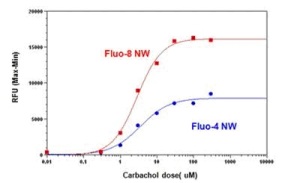In Pharma screening departments there is a strong need for Ca2+ measurement methods.
Why is this?

GPCRs (G Protein Coupled Receptors) are still major targets of pharmaceutical screenings.
Around 30-40% of all drugs on the market are directed against GPCRs.
Drugs have an impact on the GPCR activity and thus the downstream signal transduction cascade. GPCRs are linked to the activity of heterotrimeric G proteins which consist of alpha, beta and gamma subunits. These G proteins have an effect on PhosphoLipase C (PLC) which leads to the release of Inositol Phosphate 3 (IP3) which finally leads to intracellular Ca2+ mobilization (release from the endoplasmic reticulum ) – Ca2+ finally has effect on a number of further cellular processes.
The fact that GPCR activation always leads to Ca2+mobilization is commonly used to indirectly measure the impact of compounds/drug candicates on GPCRs.
Hence the need for Ca2+ measurement methods, such as the following…
1. Methods of Ca2+ measurement based on fluorescent dyes

Commonly used tools to directly measure Ca2+ are Ca2+ chelators – in this case fluorescent dyes which directly bind Ca2+.
Upon binding, the fluoresence intensity is significantly increased and can be easily measured by fluorimetric instruments. Classical dyes are Fura-2, Indo-1, Fluo-3, Fluo-4.
Fluo-8 dye is another more superior alternative when measuring intracellular calcium with 3 main benefits over classical fluorescent dyes:
- Twice as bright as Fluo-4 and four time brighter than Fluo-3
- Loading of the cell can be conducted at room temperature, meaning under less harsh conditions than with Fluo-3 and Fluo-4 which require 37°C for optimal loading
- As especially HTS screening requires homogeneous assays (assays not requiring any wash steps, to be HTS compatible), a no wash protocol for Fluo-8 (and a no wash kit) is available


2. Methods of Ca2+ measurement based on Coelenterazine
Coelenterazine belongs to the luciferin proteins which, on one hand, serve as substrates for luciferases (other well-known luciferins are firefly luciferin, snail luciferin etc). These luciferase / luciferin systems are used in a number of genetic reporter assays (e.g. Firefly luciferase reporter gene assays). Luciferins are light-emitting compounds originally found in organisms that generate biolumiscence. Upon enzyme catalzyed oxidation, they are excited to emit light.
On the other hand, the luciferin Coelenterazine can be also used as a Ca2+ detector.
Together with Apoaequorin, Coelenterazine forms the complex Aequorin.
In the presence of calcium ions, the protein undergoes a conformational change and through oxidation converts its prosthetic group (Coeelenterazine) to excited coelenteramide and CO2.
Excited coelenteramide can be measured with a luminometer (Bioluminiscence detection).
To run GPCR screening on this basis, cell lines are used which on the one hand overexpress the GPCR of interest and on the other hand express Apoaequorin (meaning they have to be double transfected with plasmid coding for both proteins).
As Coelenterazine is a hydrophobic molecule, and is therefore easily taken up across the plasma membrane of higher eukaryotes cells and can be easily loaded.
Finally the change in intracellular Ca2+ concentrations upon activation of GPCRs can be measured.
Several Coelenterazine variants are known. Native Coelenterazine and Coelenterazine analogs cp, f, h, and hcp have been used for Ca2+measurement. They all differ in their physical properties, e.g. their emission wavelengths.
Do you need tools to measure Calcium?
tebu-bio’s teams are always happy to answer any questions and offer advice. We have solutions available for both measurements strategies.
[contact-form to=’Ali.el.baya@tebu-bio.com’ subject=’Interested in Calcium measurements’][contact-field label=’Name’ type=’name’ required=’1’/][contact-field label=’Email’ type=’email’ required=’1’/][contact-field label=’Comment’ type=’textarea’ required=’1’/][/contact-form]



